Yucca
Yucca is a genus of perennial shrubs and trees in the family Asparagaceae, subfamily Agavoideae.[2] Its 40–50 species are notable for their rosettes of evergreen, tough, sword-shaped leaves and large terminal panicles of white or whitish flowers. They are native to the hot and dry (arid) parts of the Americas and the Caribbean.
| Yucca | |
|---|---|
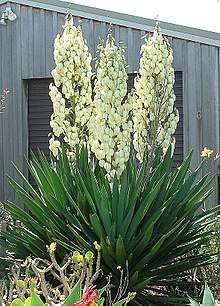 | |
| Yucca filamentosa naturalized in New Zealand | |
| Scientific classification | |
| Kingdom: | Plantae |
| Clade: | Tracheophytes |
| Clade: | Angiosperms |
| Clade: | Monocots |
| Order: | Asparagales |
| Family: | Asparagaceae |
| Subfamily: | Agavoideae |
| Genus: | Yucca L. |
| Species | |
|
See text. | |
| Synonyms | |
|
Clistoyucca (Engelm.) Trel. | |
Early reports of the species were confused with the cassava (Manihot esculenta).[3] Consequently, Linnaeus mistakenly derived the generic name from the Taíno word for the latter, yuca (spelled with a single "c").[4]
Distribution
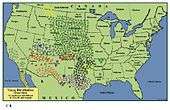
The natural distribution range of the genus Yucca (49 species and 24 subspecies) covers a vast area of the Americas. The genus is represented throughout Mexico and extends into Guatemala (Yucca guatemalensis). It also extends to the north through Baja California in the west, northwards into the southwestern United States, through the drier central states as far north as southern Alberta in Canada (Yucca glauca ssp. albertana).
Yucca is also native to some of the Caribbean Islands, northward to the coastal lowlands and dry beach scrub of the coastal areas of the southeastern United States, along the Gulf of Mexico and South Atlantic States from coastal Texas to Maryland.
Yuccas have adapted to an equally vast range of climatic and ecological conditions. They are to be found in rocky deserts and badlands, in prairies and grassland, in mountainous regions, in light woodland, in coastal sands (Yucca filamentosa), and even in subtropical and semitemperate zones, although these are generally arid to semi-arid.
Ecology
Yuccas have a very specialized, mutualistic pollination system, being pollinated by yucca moths (family Prodoxidae); the insect transfers the pollen from the stamens of one plant to the stigma of another, and at the same time lays an egg in the flower; the moth larva then feeds on some of the developing seeds, always leaving enough seed to perpetuate the species. Certain species of the yucca moth have evolved antagonistic features against the plant and do not assist in the plants pollination efforts while continuing to lay their eggs in the plant for protection.[5]
Yucca species are the host plants for the caterpillars of the yucca giant-skipper (Megathymus yuccae),[6] ursine giant-skipper (Megathymus ursus),[7] and Strecker's giant-skipper (Megathymus streckeri).[8]
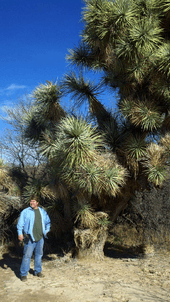
Beetle herbivores include yucca weevils, in the Curculionidae.
Adaptations
Species of yucca have adapted to a wide variety of climates in mountains, coastal sand, grasslands and prairies as well as rocky badlands and deserts. Most species of yucca have thick, waxy skins to prevent loss of water through evaporation. They frequently store water in thick roots. Some yuccas store water in thick, fleshy leaves. Some desert plants have an oily coating on their leaves or pads that traps moisture, thereby reducing water loss. Some species drop their leaves during drought to prevent the loss of water through transpiration. Dead leaves of yucca collecting against the trunk of the trees help protect it from the sun. The channeled leaves of a yucca direct dew and rainfall water to their roots. Yuccas are said to be "fire adapted"; that is, they grow and spread vigorously after wildfires.
Uses
Yuccas are widely grown as ornamental plants in gardens. Many species also bear edible parts, including fruits, seeds, flowers, flowering stems,[9] and more rarely roots. References to yucca root as food often arise from confusion with the similarly pronounced, but botanically unrelated, yuca, also called cassava or manioc (Manihot esculenta). Roots of soaptree yucca (Yucca elata) are high in saponins and are used as a shampoo in Native American rituals. Dried yucca leaves and trunk fibers have a low ignition temperature, making the plant desirable for use in starting fires via friction. The stem (when dried) that sports the flowers is often used in collaboration with a sturdy piece of cedar for making primitive fire.[10] In rural Appalachian areas, species such as Yucca filamentosa are referred to as "meat hangers". The tough, fibrous leaves with their sharp-spined tips were used to puncture meat and knotted to form a loop with which to hang meat for salt curing or in smoke houses. The fibers can be used to make cordage be it sewing thread or rope.
Gastronomy
The flower petals are commonly eaten in Central America, but its reproductive organs (the anthers and ovaries) are first removed because of their bitterness.[11] The petals are blanched for 5 minutes, and then cooked a la mexicana (with tomato, onion, chile) or in tortitas con salsa (egg-battered patties with green or red sauce). In Guatemala, they are boiled and eaten with lemon juice.[11]
In El Salvador, the tender tips of stems are eaten, and known locally as cogollo de izote.[11]
Cultivation
Yuccas are widely grown as architectural plants providing a dramatic accent to landscape design. They tolerate a range of conditions, but are best grown in full sun in subtropical or mild temperate areas. In gardening centres and horticultural catalogues they are usually grouped with other architectural plants such as cordylines and phormiums.[12]
Joshua trees (Yucca brevifolia) are protected by law in some states. A permit is needed for wild collection. As a landscape plant, they can be killed by excessive water during their summer dormant phase, so are avoided by landscape contractors.
Several species of yucca can be grown outdoors in temperate climates, including:-[12]
- Yucca filamentosa
- Yucca flaccida
- Yucca gigantea
- Yucca gloriosa
- Yucca recurvifolia
Symbolism
The yucca flower is the state flower of New Mexico. No species name is given in the citation.
Species
As of February 2012, the World Checklist of Selected Plant Families recognizes 49 species of Yucca and a number of hybrids:[13]
| Species name | Common name | ||
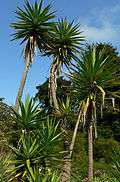 |  | Yucca aloifolia L. (Type species) (syn. Yucca yucatana) | Aloe yucca, Spanish bayonet |
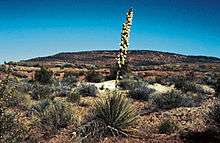 | Yucca angustissima Engelm. ex Trel. (including Yucca kanabensis) | Narrowleaf yucca, Spanish bayonet | |
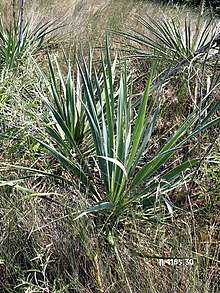 | Yucca arkansana Trel. | ||
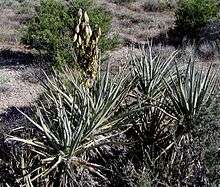 |  | Yucca baccata Torr. (including Yucca thornberi) | Banana yucca, datil |
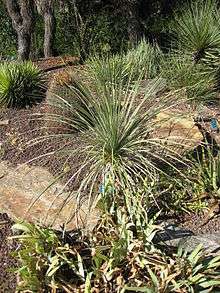 | Yucca baileyi Wooton & Standl. (syn. Yucca standleyi McKelvey) | ||
 | 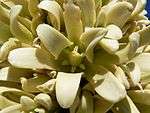 | Yucca brevifolia Engelm. | Joshua tree |
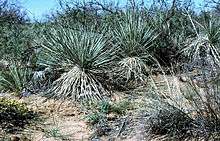 | Yucca campestris McKelvey | ||
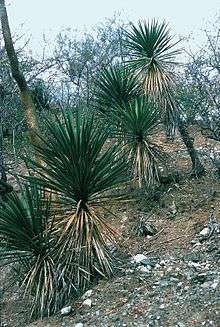 | Yucca capensis L.W.Lenz | ||
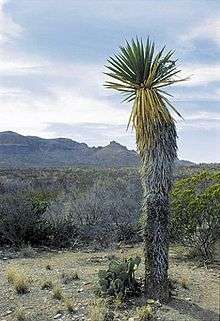 | Yucca carnerosana (Trel.) McKelvey | ||
| Yucca cernua E.L.Keith | |||
 | Yucca coahuilensis Matuda & I.L.Pina | ||
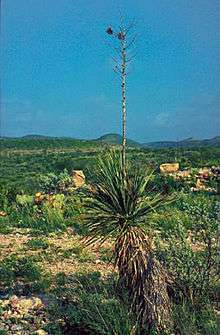 | Yucca constricta Buckley | Buckley's yucca | |
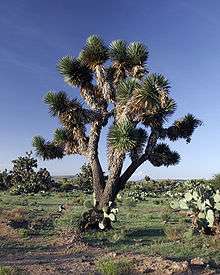 |  | Yucca decipiens Trel. | Palma china |
| Yucca declinata Laferr. | |||
| Yucca desmetiana Baker | |||
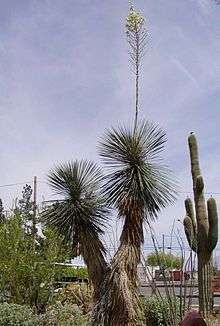 | 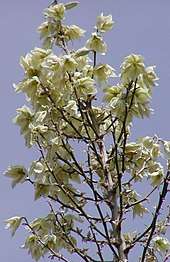 | Yucca elata (Engelm.) Engelm. | Soaptree yucca |
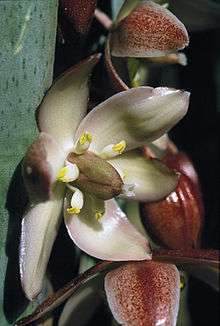 | Yucca endlichiana Trel. | ||
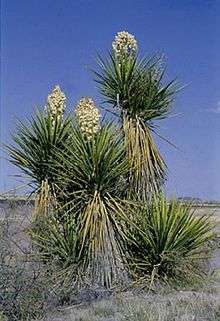 | Yucca faxoniana Sarg. (syn. Yucca torreyi) | Torrey yucca | |
 |  | Yucca filamentosa L. | Spoonleaf yucca, filament yucca, or Adam's needle |
 | Yucca filifera Chabaud | Palma china | |
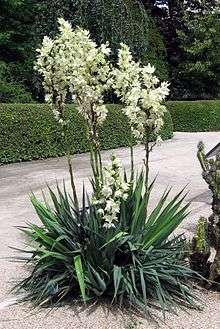 | Yucca flaccida Haw. | Flaccid leaf yucca | |
| Yucca gigantea Lem. (syn. Yucca guatemalensis) | Spineless yucca | ||
 | Yucca glauca Nutt. | Great Plains yucca | |
| Yucca gloriosa L. (including Yucca recurvifolia) | Moundlily yucca, Adam's needle, Spanish dagger | ||
 | Yucca grandiflora Gentry | Sahuiliqui yucca | |
 | Yucca harrimaniae Trel. (syn. Yucca nana) | Harriman's yucca | |
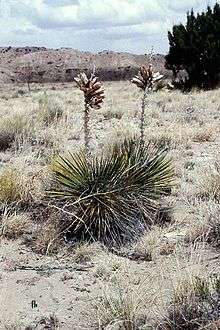 | Yucca intermedia McKelvey | Intermediate yucca | |
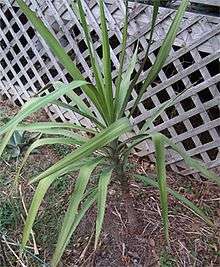 | Yucca jaliscensis (Trel.) Trel. | Izote | |
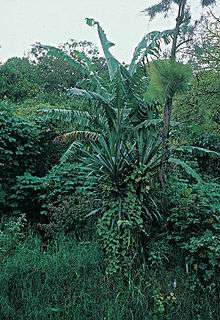 | Yucca lacandonica Gómez Pompa & J.Valdés | Tropical yucca | |
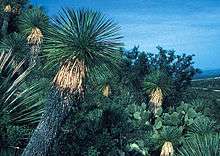 | Yucca linearifolia Clary | ||
 | Yucca luminosa (syn. Yucca rigida) | Blue yucca | |
| Yucca madrensis Gentry | Soco yucca | ||
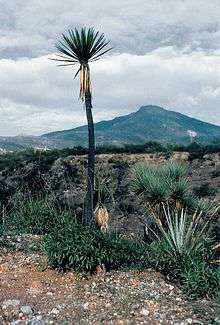 | Yucca mixtecana García-Mend. | ||
| Yucca necopina Shinners | |||
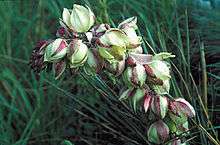 | Yucca neomexicana Wooton & Standl. | New Mexican Spanish bayonet | |
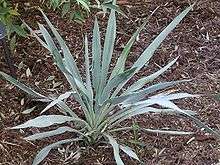 | Yucca pallida McKelvey | Pale yucca | |
 | Yucca periculosa Baker | Izote | |
 | Yucca potosina Rzed. | ||
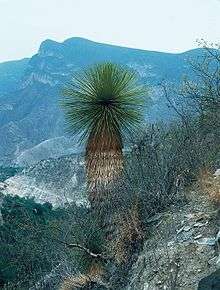 | Yucca queretaroensis Piña Luján | ||
| Yucca reverchonii Trel. | |||
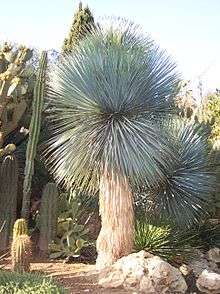 | Yucca rostrata Engelm. ex Trel. | Beaked yucca, Big Bend yucca | |
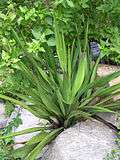 | Yucca rupicola Scheele | Texas yucca, or twist-leaf yucca | |
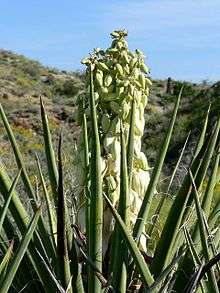 | Yucca schidigera Roezl ex Ortgies | Mojave yucca | |
 | Yucca × schottii | Hoary yucca or mountain yucca | |
 | Yucca sterilis (Neese & S.L.Welsh) S.L.Welsh & L.C.Higgins | ||
| Yucca tenuistyla Trel. | |||
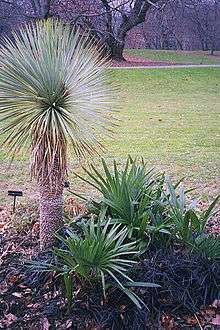 | Yucca thompsoniana Trel. | Thompson's yucca | |
_Bot._Mag._86._t._5201._1860..jpg) | Yucca treculeana Carrière | Texas bayonet, Trecul's yucca | |
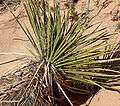 |  | Yucca utahensis McKelvey | |
 | Yucca valida Brandegee | Datilillo | |
A number of other species previously classified in Yucca are now classified in the genera Dasylirion, Furcraea, Hesperaloe, Hesperoyucca, and Nolina.
Taxonomic arrangement
- Section Yucca formerly Sarcocarpa Engelm.
- Series Faxonianae Hochstätter
- Series Baccatae Hochstätter
- Yucca baccata Torr.
- Yucca baccata Torr. ssp. baccata
- Yucca baccata Torr. ssp. vespertina (McKelvey) Hochstätter
- Yucca baccata Torr. ssp. thornberi (McKelvey) Hochstätter
- Yucca confinis McKelvey
- Yucca endlichiana Trel.
- Yucca arizonica McKelvey
- Yucca baccata Torr.
- Series Treculianae Hochstätter
- Yucca grandiflora Gentry
- Yucca declinata Laferr.
- Yucca treculiana Carriere
- Yucca torreyi Shafer
- Yucca schidgera Roezl ex Ortgies
- Yucca schotti Engelm.
- Yucca capensis Lenz
- Yucca jaliscensis Trel.
- Yucca periculosa Baker
- Yucca mixtecana Garcia-Mend.
- Yucca decipiens Trel.
- Yucca valida Brandegee
- Yucca potosina Rzed.
- Yucca filifera Chabaud
- Series Gloriosae Hochstätter
- Yucca gloriosa L.
- Yucca recurvifolia Salisb.
- Series Yucca
- Yucca madrensis Gentry
- Yucca linearifolia Clary
- Yucca elephantipes Regel
- Yucca lacandonica Gomez-Pompa & Valdes
- Yucca aloifolia L.
- Yucca yucatana Engelm.
- Section Clistocarpa Engelm.
- Yucca brevifolia Engelm.)
- Yucca brevifolia Engelm. ssp. brevifolia
- Yucca brevifolia Engelm. ssp. jaegeriana (McKelvey) Hochstätter
- Yucca brevifolia Engelm. ssp. herbertii (Webber) Hochstätter
- Yucca brevifolia Engelm.)
- Section Chaenocarpa Engelm.
- Series Filamentosae Hochstätter
- Series Rupicolae Hochstätter
- Yucca cernua Keith
- Yucca pallida McKelvey
- Yucca queretaroensis Pina Lujan
- Yucca reverchonii Trel.
- Yucca rigida (Engelm.) Trel.
- Yucca rostrata Engelm. ex Trel.
- Yucca rupicola Scheele
- Yucca thompsoniana Trel.
- Series Harrimaniae Hochstätter
- Yucca harrimaniae Trel.
- Yucca harrimaniae Trel. ssp. harrimaniae
- Yucca harrimaniae Trel. ssp. neomexicana (Wooton & Standl.) Hochstätter
- Yucca harrimaniae Trel. ssp. sterilis (Neese & Welsh) Hochstätter
- Yucca harrimaniae Trel. ssp. gilbertiana (Trel.) Hochstätter
- Yucca nana Hochstätter
- Yucca harrimaniae Trel.
- Series Glaucae (McKelvey) Hochstätter
- Yucca angustissima Engelm. ex Trel.
- Yucca angustissima Engelm. ex Trel. ssp. angustissima
- Yucca angustissima Engelm. ex Trel. ssp. toftiae (Welsh) Hochstätter
- Yucca angustissima Engelm. ex Trel. ssp. kanabensis (McKelvey) Hochstätter
- Yucca angustissima Engelm. ex Trel. ssp. avia (Reveal) Hochstätter
- Yucca baileyi Wooton & Standl.
- Yucca baileyi Wooton & Standl. ssp. baileyi
- Yucca baileyi Wooton & Standl. ssp. intermedia (McKelvey) Hochstätter
- Yucca coahuilensis Matuda & Pinja Lujan
- Yucca elata Engelm.
- Yucca elata Engelm. ssp. elata
- Yucca elata Engelm. ssp. utahensis (McKelvey) Hochstätter
- Yucca elata Engelm. ssp. verdiensis (McKelvey) Hochstätter
- Yucca glauca Nutt.
- Yucca glauca Nutt. ssp. glauca
- Yucca glauca Nutt. ssp. stricta (Sims) Hochstätter
- Yucca glauca Nutt. ssp. albertana Hochstätter
- Yucca campestris McKelvey
- Yucca constricta Buckley
- Yucca arkansana Trel.
- Yucca arkansana Trel. ssp. arkansana
- Yucca arkansana Trel. ssp. louisianensis (Trel.) Hochstätter
- Yucca arkansana Trel. ssp. freemanni (Shinners) Hochstätter
- Yucca angustissima Engelm. ex Trel.
- Section Hesperoyucca Engelm.
- (Treated as a separate genus Hesperoyucca by some sources.)
- Yucca whipplei Torr.
- Yucca whipplei Torr. ssp. whipplei
- Yucca whipplei Torr. ssp. caespitosa (Jones) Haines
- Yucca whipplei Torr. ssp. intermedia Haines
- Yucca whipplei Torr. ssp. percursa Haines
- Yucca whipplei Torr. ssp. newberryi (McKelvey) Hochstätter
- Yucca whipplei Torr. ssp. eremica Epling & Haines
- Yucca whipplei Torr.
- (Treated as a separate genus Hesperoyucca by some sources.)
Cultivars
In the years from 1897 to 1907, Carl Ludwig Sprenger created and named 122 Yucca hybrids.
Gallery
 Joshua trees (Yucca brevifolia), growing in the Mojave Desert
Joshua trees (Yucca brevifolia), growing in the Mojave Desert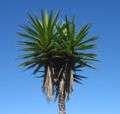 Unknown species near Orosí, Costa Rica
Unknown species near Orosí, Costa Rica- Yucca near Carlsbad Caverns National Park in New Mexico
 Yucca harrimaniae also known as Harriman's yucca
Yucca harrimaniae also known as Harriman's yucca- Yucca faxoniana in Texas, with mature fruits
_Series_Treculianae_Yucca_schidigera_fh_1183.9_NV_en_B.jpg) Yucca schidigera in Nevada, in full bloom
Yucca schidigera in Nevada, in full bloom
References
- "Yucca L." Germplasm Resources Information Network. United States Department of Agriculture. 2010-01-19. Retrieved 2010-06-07.
- Chase, M.W.; Reveal, J.L. & Fay, M.F. (2009), "A subfamilial classification for the expanded asparagalean families Amaryllidaceae, Asparagaceae and Xanthorrhoeaceae", Botanical Journal of the Linnean Society, 161 (2): 132–136, doi:10.1111/j.1095-8339.2009.00999.x
- Irish, Gary (2000). Agaves, Yuccas, and Related Plants: a Gardener's Guide. Timber Press. p. 18. ISBN 978-0-88192-442-8.
- Quattrocchi, Umberto (2000). CRC World Dictionary of Plant Names. 4 R-Z. Taylor & Francis US. p. 2862. ISBN 978-0-8493-2678-3.
- SEGRAVES, KARI A.; ALTHOFF, DAVID M.; PELLMYR, OLLE (1 October 2008). "The evolutionary ecology of cheating: does superficial oviposition facilitate the evolution of a cheater yucca moth?". Ecological Entomology. 33 (6): 765–770. doi:10.1111/j.1365-2311.2008.01031.x.
- Daniels, Jaret C. "Yucca Giant-Skipper Butterfly, Megathymus yuccae (Boisduval & Leconte) (Insecta: Lepidoptera: Hesperiidae)". Electronic Data Information Source. University of Florida IFAS Extension. Retrieved 2010-06-07.
- "Ursine Giant-Skipper Megathymus ursus Poling, 1902". Butterflies and Moths of North America. Retrieved 2010-06-07.
- "Strecker's Giant-Skipper Megathymus streckeri (Skinner, 1895)". Butterflies and Moths of North America. Retrieved 2010-06-07.
- Couplan, François (1998). The Encyclopedia of Edible Plants of North America. McGraw Hill Professional. ISBN 978-0-87983-821-8.
- Baugh, Dick (1999). "the Miracle of Fire by Friction". In David Wescott (ed.). Primitive Technology: A Book of Earth Skills (10 ed.). pp. 32–33. ISBN 978-0-87905-911-8.
- Pieroni, Andrea (2005). Prance, Ghillean; Nesbitt, Mark (eds.). The Cultural History of Plants. Routledge. p. 33. ISBN 0415927463.
- RHS A-Z encyclopedia of garden plants. United Kingdom: Dorling Kindersley. 2008. p. 1136. ISBN 1405332964.
- World Checklist of Selected Plant Families, The Board of Trustees of the Royal Botanic Gardens, Kew, retrieved 2012-02-23, search for "Yucca"
- General
- Fritz Hochstätter (Hrsg.): Yucca (Agavaceae). Band 1 Dehiscent-fruited species in the Southwest and Midwest of the USA, Canada and Baja California , Selbst Verlag, 2000. ISBN 3-00-005946-6
- Fritz Hochstätter (Hrsg.): Yucca (Agavaceae). Band 2 Indehiscent-fruited species in the Southwest, Midwest and East of the USA, Selbst Verlag. 2002. ISBN 3-00-009008-8
- Fritz Hochstätter (Hrsg.): Yucca (Agavaceae). Band 3 Mexico , Selbst Verlag, 2004. ISBN 3-00-013124-8
External links
| Wikimedia Commons has media related to Yucca. |
| Wikispecies has information related to Yucca |

- Yucca species and their Common names - Fritz Hochstätter
- New Mexico Statutes and Court Rules: State Flower
- . Encyclopædia Britannica (11th ed.). 1911.